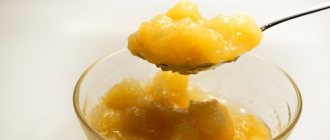How can early complementary feeding be dangerous?
The introduction of complementary foods is allowed from 4 months. Until this age, the baby’s body is not ready to digest food other than the composition of breast milk. From about 4 months, the production of hydrochloric acid in the stomach begins, and enzymes are stimulated to break down incoming food. The permeability of the intestinal mucous membranes for large particles is reduced, and the possibility of allergic manifestations also decreases. Around this age, the reflex of the newborn’s tongue to push out thick and hard food fades away.
Attention! It is too early for breastfeeding babies to start complementary feeding at 4 months. The introduction of new food is permissible only according to the indications of a pediatrician.
It is not recommended to introduce complementary foods before 4 months
All parents should know and understand that all children have individual developmental characteristics. Not every child’s body is ready for a diet change at 4 months. Late intake of new food can cause pain, bloating, diarrhea, constipation, and gas formation in the intestines. Insomnia, moodiness, decreased appetite and weight may occur.
When these reactions occur, it is advisable to postpone innovations for a while. But the reason may not be that the baby’s body is not ready for another food, but is associated with intolerance to the new nutritional component. Therefore, it is advisable to consult a pediatrician.
Ignoring the symptoms of untimely innovations can lead to gastrointestinal disorders in the future. There may also be a tendency to allergies, decreased immunity, and susceptibility to infectious diseases. Due to the unpleasant first experience, the child may refuse to eat in the future.
Why might early complementary feeding be necessary?
There are cases when doctors may recommend introducing early complementary feeding
Indications for introducing the first complementary foods from 4 months are:
- artificial feeding;
- prematurity;
- underweight;
- vitamin deficiency, rickets;
- refusal of mixture or breastfeeding;
- the child does not eat enough.
Start early complementary feeding only on the recommendation of the observing pediatrician. Today, formulas are fully adapted for feeding babies; new products can be postponed until the age of 5 months. Complementary feeding for breastfeeding children aged four months is considered early and is introduced only as prescribed by a specialist.
How to understand that a child is ready to introduce complementary foods?
The readiness for additional nutrition of a child from 4 months can be judged by external signs. They are not decisive, but indicate the maturation of the nervous and digestive systems of the baby’s body.
The baby watches with interest the adults' meals, dragging everything he can get his hands on into his mouth. Ability to sit and hold your head confidently is desirable. This is important so that he can turn away and demonstrate his reluctance to eat. You can't force feed.
It is important that the reflex of pushing out food with the tongue does not interfere, and the ability to stretch the lower sponge appears. Otherwise, the baby will not be able to swallow anything, will choke, and may start vomiting. The weight should increase from the moment of birth by 2, for premature babies - by 2.5 times. Another sign is an increase in the number of feedings. May indicate malnutrition, formula or milk deficiency. Indirect signs include the eruption of the first tooth, normal stool in response to the innovation, and the ability to chew food.
The appearance of the first tooth is evidence that the first complementary foods can be introduced.
How to freeze zucchini for complementary feeding?
Unfortunately, fresh zucchini can only be purchased from us in the summer. But children also require healthy food on winter days. In order to provide the baby with vitamins in winter, zucchini must be frozen. However, this must be done correctly.
For these purposes, it is best to use small young zucchini. They must be washed under running water, peeled and cut into small pieces. Wait until they are dry from the water, place them in a plastic bag and then in the freezer.
Useful: How to properly prepare soup for a one-year-old baby?
This way you can cook vitamin puree for your baby and prepare healthy juices not only in summer, but also in winter!
Rules for introducing complementary foods at four months
Basic principles for starting complementary feeding for a baby at 4 months:
- Introduce a new product once every 1-2 weeks.
- The beginning of complementary feeding is one-component vegetable puree or porridge. Multicomponent mixtures are prohibited at this age.
- First solid food, then breastfeeding or an adapted formula.
- Food must be liquid, homogeneous, homogenized in structure.
- Spoon feed.
- Gradually increasing the portion of the new product.
- Canceling complementary foods for symptoms of allergies or disorders of the digestive tract.
- Changing the diet is prohibited in preparation for vaccination, or for several days after if the child is sick.
- After a month, replace 1-2 feedings with new food.
- Keeping a food diary. This is especially important for children prone to allergic manifestations.
Because it is too early to introduce complementary foods during breastfeeding at 4 months, there must be good reasons and a pediatrician’s prescription. The main indications are lack of weight, anemia, vitamin deficiency. Breast milk contains antibodies and enzymes for the normal functioning of the immune and digestive systems. Breastfeeding should continue for up to 6 months as the only food source. Supplementing with solid foods can negatively affect lactation.
Important! The introduction of complementary foods to breastfeeding children should be accompanied by teaching them to drink clean water. Often infants are not fed extra food, because breast milk provides the body with the necessary volume of fluid. When introducing solid foods, water should be given. Otherwise, constipation may occur.
For the first feeding, it is recommended to use vegetable puree.
Introducing complementary foods to formula-fed babies
Formula feeding is one of the reasons for introducing early complementary feeding. No matter how adapted the formula is, it cannot compare with mother's milk. Therefore, IV is an indication for expanding the diet.
It is necessary to introduce complementary feeding at 4 months only if there are external signs of the child’s readiness. It is important to be able to sit and turn your head freely. You must first consult with your pediatrician.
Compliance with the rules and scheme for introducing a new product will protect against negative consequences for the baby. Makes the process simple and fun.
Where to start early complementary feeding?
It is advisable to make puree for complementary feeding as one-component
The introduction of complementary foods into the diet of a 4-month-old baby begins with vegetable puree or cereals. An important condition is single-componentity. Give a mixture of several vegetables and porridge from a set of cereals only after introducing all these ingredients into the diet one at a time. This is necessary in order to know for sure what caused the negative reaction of the body.
Vegetables should be included in the diet when the baby is prone to constipation. The fiber they contain will enhance intestinal motility and help with dysbacteriosis. The choice in favor of cereals should be made in case of the opposite problem - loose stools, as well as in case of underweight. Porridge strengthens and helps normalize stool. Add a little vegetable oil to vegetables, and butter to porridges.
Important! It is not advisable to start a new diet with fruit purees and juices. After fruit, the child is unlikely to want to eat bland vegetables and porridge without sugar.
What can you give to a child from 4 months?
A 4-month-old baby should start complementary feeding with white and green vegetables (zucchini, broccoli, cauliflower). You can give potatoes, but not first and if the baby does not have digestive problems, because they contain starch. Introduce pumpkin, carrots, and tomatoes with caution. Vegetables with bright colors can cause allergies.
You can use ready-made canned one-component puree with markings allowing its use from 4 months. It is important to inspect the jar, check whether the lid is swollen, the expiration date, and the uniformity of the composition. Before giving it to your child, be sure to try the contents. The use of industrially produced vegetable puree is especially justified in winter and early spring, when natural vegetables are imported or do not contain the necessary nutrients after long storage.
In summer and autumn, it is advisable to cook yourself from seasonal, local, fresh vegetables. It won’t take much time, but the child will receive a fresh, tasty, healthy dish. Vegetables can be frozen for the winter, but long-term storage is undesirable.
Start getting acquainted with cereals with gluten-free ones: rice, buckwheat, corn grits. Gluten is a plant protein that often causes allergies. If you are prone to diarrhea and loose stools, add rice porridge; if you have anemia, add buckwheat.
Porridge can be cooked from cereal ground in a coffee grinder, which will significantly reduce the cooking time and make the porridge the required consistency without hard pieces. Or grind the cooked cereal in a blender.
It is better to prepare purees and porridges for complementary feeding yourself
You can buy ready-made porridges. No need to cook, just dilute with hot water. It is necessary to look at the expiration dates and the composition of the porridge. It is advisable to mark it as hypoallergenic. You should choose according to age, without milk in the mixture.
On a note! Vegetable oil should be given with vegetables. No more than 5 drops per 100 g of product. Butter is added to porridge. It is introduced into the diet later than vegetable.
Volume of complementary foods
Volume of first feeding by day:
- 1 – 1/2 tsp;
- 2 – 1 tsp;
- 3 – 2 tsp;
- 4 – 3 tsp;
- by day 7 the portion should be 100 g.
The volume of complementary foods at 4 months with breastfeeding is the same as with artificial feeding. The only difference is that with breastfeeding it can be pedagogical, i.e., what the baby wants (from allowed products) is given; it is not necessary to completely replace their food intake. If the mother has sufficient milk and the baby has good weight gain, breast milk can be left as the main food for up to 1 year. This does not mean that there should be no complementary feeding. But if a child refuses to eat, there is no need to force it.
How to introduce a new product?
After introducing each new product, it is necessary to ensure that the baby does not have an allergic reaction.
When starting complementary feeding at 4 months, the product is first introduced in the amount of ¼-½ children's teaspoon. Time: first half of the day, preferably breakfast. If within a week, with daily use of the product and increasing portions, the baby did not experience any digestive problems or allergic manifestations, then the next week the next one should be introduced.
From the second week, add the second product in the same way. It may be from the same food group or from another. That is, if you introduced zucchini, then in week 2 you can add broccoli to it according to the same scheme. In this case, the portion of zucchini is initially 70-100 g and is reduced by the volume to which broccoli is added. On day 7, the entire portion will consist of broccoli.
If porridge is introduced, then the zucchini can be left in the same amount for lunch, and it can be introduced according to the scheme for breakfast. As a result, by the end of 2 weeks, 2 feedings will be replaced with complementary foods. Porridge in the morning, vegetable at lunch. In this case, at week 3 you should not immediately try new cereals and new vegetables. You only need to add variety to one meal. This scheme is not suitable for all children, since breakfast and lunch are replaced at once.
Attention! Keeping a food diary is a must. It is important to record the product introduced, time of meal, and volume eaten. It is also necessary to record any changes in the baby’s well-being and behavior.
The benefits of zucchini during the first feeding
Zucchini is a storehouse of vitamins and minerals; it is well absorbed by the child’s body and does not cause allergies at all. Despite the fact that breastfeeding provides the baby with all the necessary microelements, with age he will still not have enough of the nutrients that enter the body with milk. This primarily concerns iron and zinc. It is these microelements that an infant begins to need at the age of 5–6 months.
Zucchini is incredibly easy to cook, and there are so many useful substances in it! In addition, it will contain:
- unsaturated fatty acids;
- B vitamins;
- vitamin A, C, PP and H;
- chemical microelements (iron, zinc, sulfur, calcium, magnesium, potassium and many others);
- monosaccharides;
- disaccharides;
- organic acids;
- alimentary fiber.
It also contains proteins, carbohydrates and fats necessary for normal functioning. Therefore, its presence in the baby’s diet should be mandatory.
Zucchini is traditionally the first vegetable a baby tries.
Complementary feeding scheme from 4 months - table
Complementary feeding chart for children from 4 months
| Month | Meal time, h | ||||
| 6.00 | 10.00 | 14.00 | 18.00 | 22.00 | |
| 4 | GV or adapted mixture | GW or mixture | Vegetable puree 80-100 g, GV or mixture | GW or mixture | GW or mixture |
| 5 | GV or adapted mixture | Porridge 140 g, fruit puree 60 g | Vegetable puree 100-120 g, GV or mixture | Curd 30 g, juice 50 ml, GV or mixture | GW or mixture |
| 6 | GV or adapted mixture | Porridge 150 g, juice 30 ml, yolk 1/4 part | Vegetable puree 120-150 g, meat puree 40 g, juice 30 ml | Curd 30 g, fruit puree 30 g, GV or mixture | GW or mixture |
Scheme for introducing complementary foods from 4 months with breastfeeding by day:
- 1 – 1/2 tsp. broccoli, GV
- 2 – 1 tsp. broccoli, GW
- 3 – 2 tsp. broccoli, GW
- 4 – 3 tsp. broccoli, GV
- 5 – 4 tsp. broccoli, GV
- 6 – 60-80 g broccoli, GV
- 7 – 70-100 g broccoli, GV
- 8 – 1/2 tsp. zucchini, remaining volume up to 70-100 g broccoli puree, GV
- 9 – 1 tsp. zucchini, the remaining volume is up to 70-100 g of broccoli puree, GV, etc.
How to introduce zucchini into the diet of babies
For the first time, it is best to prepare zucchini puree for the baby. An important nuance - no need to add salt to it. Small children, unlike adults, normally perceive the natural taste of products, especially zucchini. For the first time it can be offered in six months. If the baby is artificial - earlier, at 4-5 months. It should be introduced into the diet with extreme caution, according to the following scheme:
- Give the first portion in the morning - no more than 5 g, this is about half a teaspoon;
- each subsequent portion should be 5 g more than the previous one - within a week;
- bring the norm to 50 g (approximately).
When the baby grows up, he can be given about 60–70 g of zucchini puree for morning feeding (7–8 months). Most often, zucchini is offered in combined purees - with carrots, potatoes, and onions, of course, if the child tolerates it well. By 10 months, the baby becomes almost big - his portion by this time can be 100 g.
Important! First, give complementary foods and only after that - breast milk or baby food.
Closely monitor your child's behavior and health. Has the stool become looser? This is not a cause for alarm, but you need to be more vigilant. Do you have suspicious skin rashes? Eliminate zucchini from the menu for 10–14 days, then reintroduce it into the diet. If there are problems again, don’t offer them again for up to a year.
Foods and recipes for first feeding
You can buy vegetable purees in glass jars or instant cereals with an age mark of 4 months. When preparing it yourself, you should not use salt and sugar for the first time. If the new food does not cause digestive problems, you can start adding more salt. But to an adult, the dish should not seem salty.
A menu for a 4-month-old baby may include zucchini, broccoli or cauliflower, water-based porridge made from buckwheat, rice or corn grits. It is acceptable to introduce fruit juice and puree. It is advisable to introduce them after the child gets used to vegetables.
Cooking vegetables
All vegetables for puree must be pre-heat-treated
To prepare vegetable puree, you need to choose ripe, undamaged vegetables. There should be no signs of spoilage. It is important that they are local and in season. Rinse the product thoroughly with running water. Peel if necessary. Place in boiling water and cook until tender.
Cool the cooked vegetable slightly and grind with a blender to a homogeneous mass. Lumps are unacceptable, there is a high risk that the baby will choke. You can add 2-5 drops of high quality natural vegetable oil per 100 g of product. Start adding oil 1 drop at a time. Salting is not advisable.
How to cook zucchini?
Everyone knows that heat treatment contributes to the loss of beneficial properties of vegetables and fruits. To prevent this from happening with zucchini, it must be properly cooked. How long should it be cooked? No more than 10 minutes in boiling water.
Zucchini cooks very quickly, and this time is enough for it to become soft, while retaining all its beneficial properties.
Cook baby zucchini in small portions in a small saucepan over medium heat. First you need to rinse it under running water, peel it and rinse it again. Only cold water is used. Then cut it into circles 1 - 1.5 cm thick. Put the peeled zucchini in a saucepan and add a small amount of water. There should not be a lot of it, it should only slightly cover the vegetable. Cook for 10 minutes. This way you will also prepare vegetable broth, which can also be given to your baby or diluted into purees.
Useful: Recommendations from pediatricians regarding the menu of an 11-month-old baby
You can also cook zucchini using a double boiler. This option, by the way, is much better than the first. Because by steaming, you retain more nutrients. True, you won’t be able to make broth like this, and the puree will have to be diluted with breast milk. Steaming the zucchini also takes about 10 minutes.
You cannot add salt and various spices while cooking vegetables.
It is important that the puree is not too thick, because it is easier for the baby to cope with a more familiar consistency











